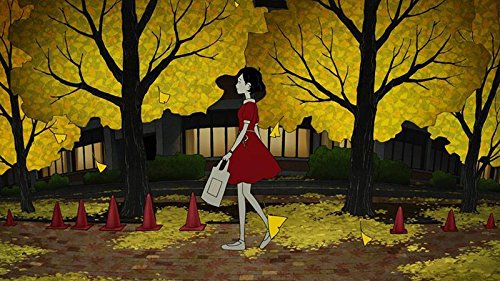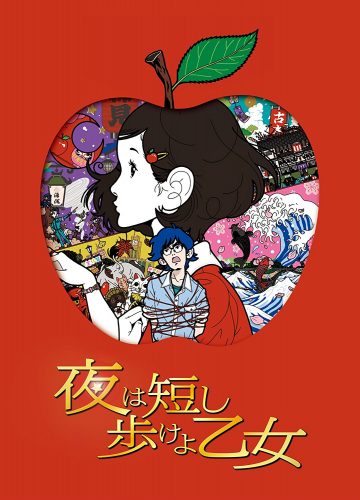
The Night is Short, Walk on Girl is a film directed by Masaaki Yuasa, the mastermind behind Devilman: Crybaby, Mind Game, Kaiba, and The Tatami Galaxy--the series that shares characters with the film. Yuasa’s visually rich and imaginative directing is a hallmark of his style, inviting viewers into a colorful new world, dense with visual techniques.
For this article, we will be discussing how Yuasa directs The Night is Short, Walk on Girl and how the whimsical visuals, masterful editing, and speedy rhetoric of the film creates an experience of a majestic night out.
The Director, Editor, and Writer: The A-Team
In animation, the editor, writer, and director work together to create a scene. After scenes have been constructed via storyboards, the “shooting” process of the movie—the animation—comes later.
In live action movies, the editorial department is separate. Normally, after a movie is filmed, editors do their work (post-processing). However, in animation, editors are part of the decision-making process. This synergy between roles is important to understand. After all, this film is about interconnectedness.
The Adult Fairy Tale: The Film’s Story and Structure
The Night is Short, Walk on Girl is segmented into 4 distinct parts: the journey to find imitation Denki Bran (alcohol), the journey to find a book (Ratatatam), the journey to find a lost love, and the journey to cure the town of sickness. Each particular arc has a goal/objective that develops its characters.
From the onset, the characters and story are layered. Each character is assigned a role--much like a play--and through each arc, their role becomes reinforced and developed. An example would be the recurring “villain,” an eccentric old man named Rihaku. Throughout the film, much of his role is to create obstacles or fund chaotic activities (his emblem is on the traveling actors’ tapestry). Despite his early negative role, the interconnectedness of the story allows him to be “cured” in the final arc.
Similarly, other characters have a running theme or gag. The father who constantly loses his investments to freak acts of nature (or ridiculous misfortune) has involved himself with “Senpai,” the male protagonist whose misfortunes are similar.
The absurdity of misfortune is both a joke and a plot element. It is reminiscent of romcoms where “chance” and “coincidence” are often plot devices to move the story/characters. By creating an eccentric connection between characters, layering character development, and using chance/coincidence liberally, the film portrays a fairy tale that lasts a single night.
How Visuals Aid Story and Dialogue
As mentioned earlier, the story has its characters pursue something tangible. This divides the plot into neat and easily-consumable segments. As viewers watch the film, they become accustomed to the characters and their overarching motivations. This means if you miss a specific reason for a scene, your overall knowledge of the characters can inform you. This is important because of how dialogue is handled.
The dialogue is fast-paced and full of beats--a pause, event, emotional change, decision or revelation that affects how a character moves towards their goal. Merely blinking can have you lose track about a character’s intentions. To ease viewers into the film, there are visual aids.
The use of colors and spacing is one example. To dictate that an arc has changed or a theme has surfaced, color is used to show change. In the first arc, color distinguishes different groups of people. For example, the group of old gentlemen (former sophists) is color-coded by brown, yellow, white, and red. Mesmerizing scenes of jubilation or fantastic tales of misfortune are given less defining lines, emphasizing the vibrant colors--the disconnect from reality.
Spacing is used to cue viewers about a character’s headspace (alienated) or the environment they enter--the journey to Rihaku’s ship is visually spaced into foreground and background, creating an impression of entering a different world where rules are different. This helps emphasize the wealth of Rihaku but also the different philosophies between the main heroine and Rihaku.
A Cohesive Whole: Masterful Editing and Visuals
To promote the film’s fairy tale atmosphere, the editing and visuals are overtly synergetic. Throughout the film, there are coincidences of nature or events that allow for scenes to transition from one to the next. When you watch a scene, the small details reveal the intentions behind the transitions.
For example, after the second arc has completed (the book arc), there is a scene where Hanuki has a fever and she is resting upon a pile of stacked books. This scene opens up first with a closeup of a daruma. Upon the sound of Higuchi’s footsteps, the scene cuts (on sound) to show Higuchi approaching a sick Hanuki. Higuchi finishes his line, and when the main heroine speaks, they cut to her approaching, both kneeling in worry.
A chant occurs offscreen, thus providing an opportunity to cut. This introduces the “guerilla actors.” They expand the frame for their mobile stage and upon finishing, the scene cuts to the director, juggling the daruma. Once the director is shown, there is another cut using the sound of the curtains folding, giving the viewers an establishing shot of the towering stage. The camera pans downwards to show the characters speaking about what they saw--now the next arc has been introduced.
After multiple segments, the scene finally comes to a conclusion. A gust of wind appears across the screen, allowing a cut to a tree in the background. A leaf blows by to help the transition, and Hanuki says, “When I’m with you, the night seems longer… I’ll go take Hanuki home. Let’s meet at the festival.” The scene introduces a logical connection to the next arc and transitions brilliantly with the same wind and leaves.
Final Thoughts

The Night is Short, Walk on Girl is an extremely performative movie, escalating itself with its cohesive writing, editing, and directing. Once viewers understand the movie’s whimsical nature, the film becomes a modern fairy tale for an adult audience. If you’ve ever wondered how to make an engaging dialogue-heavy film, look no further.

